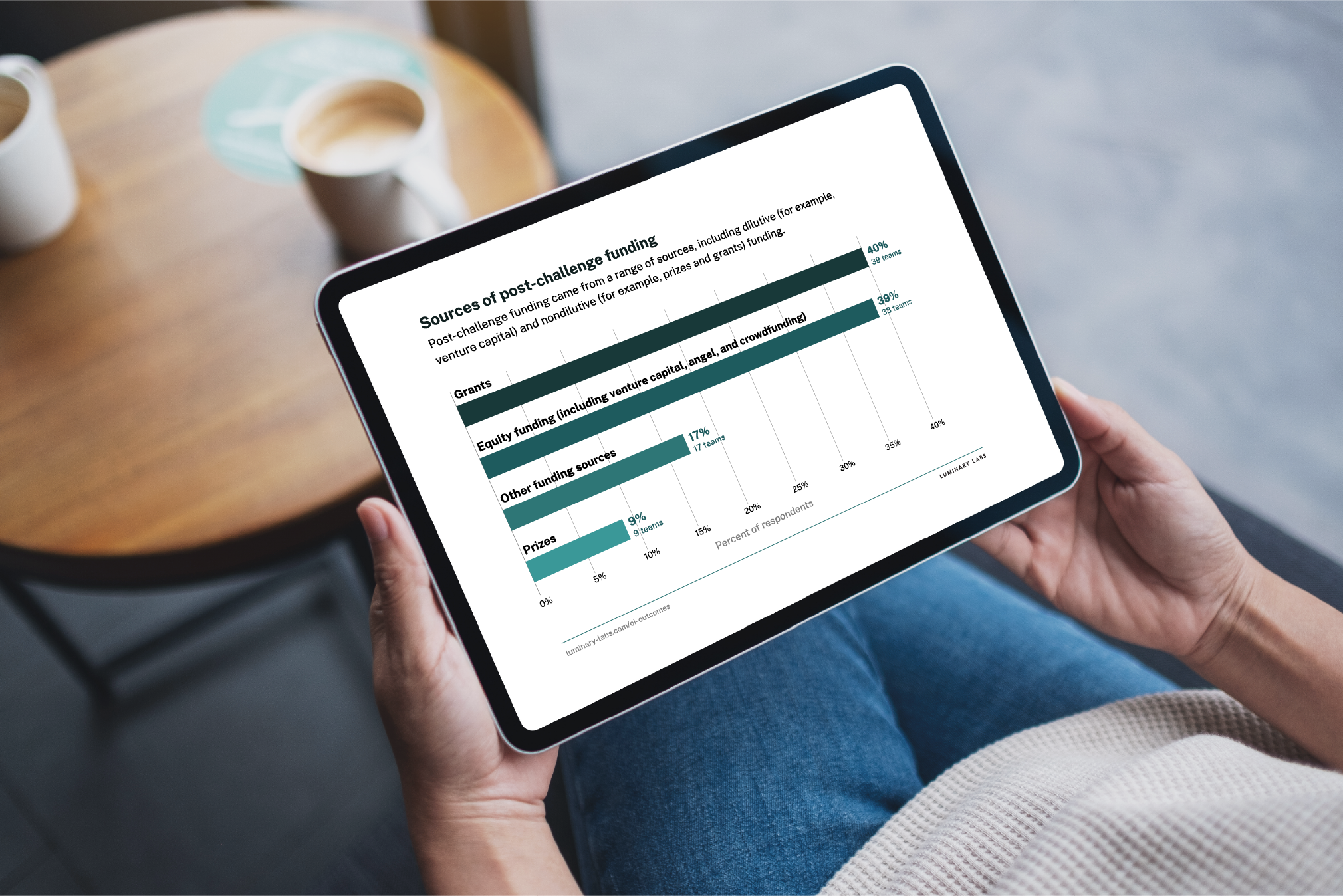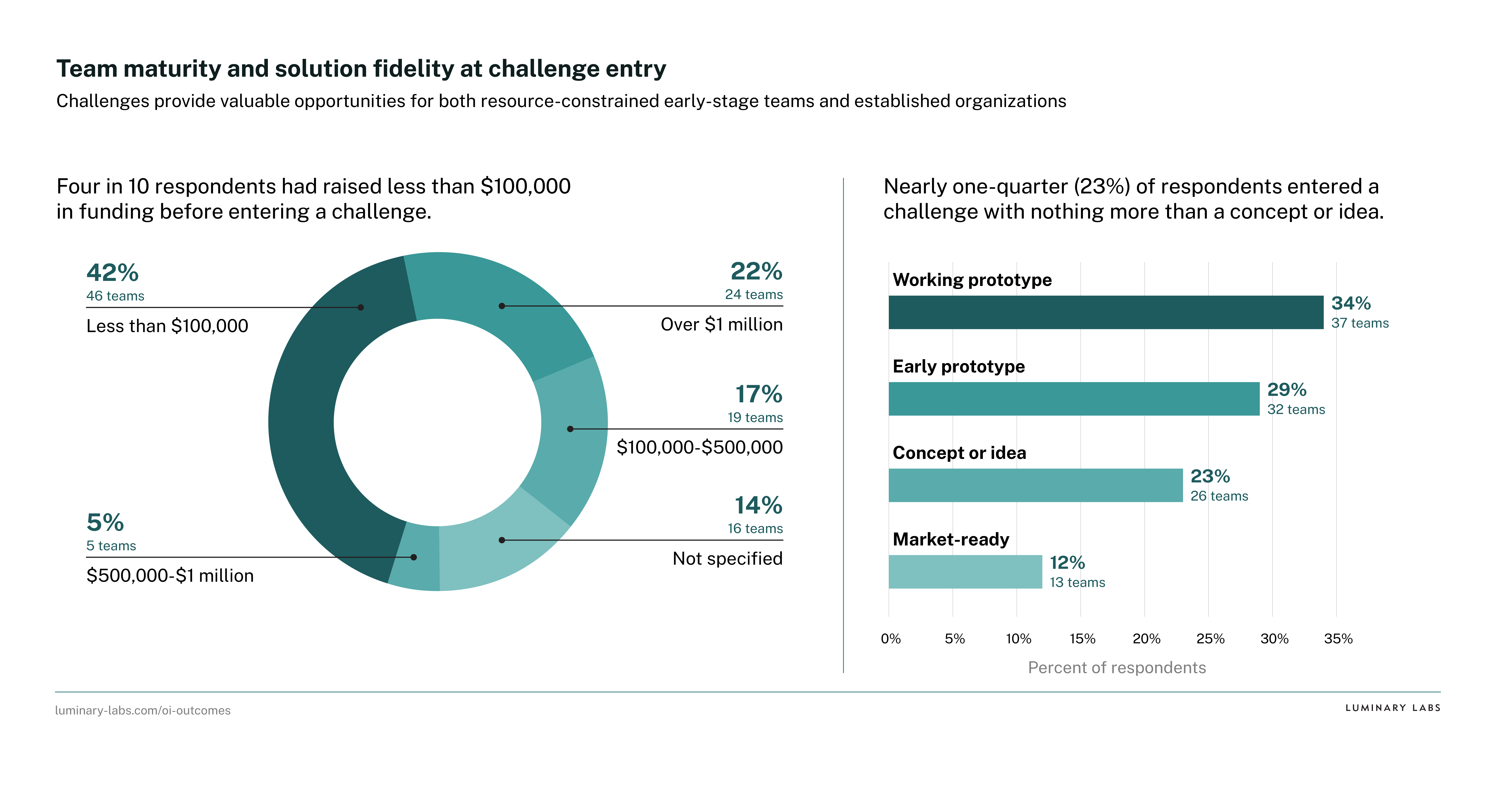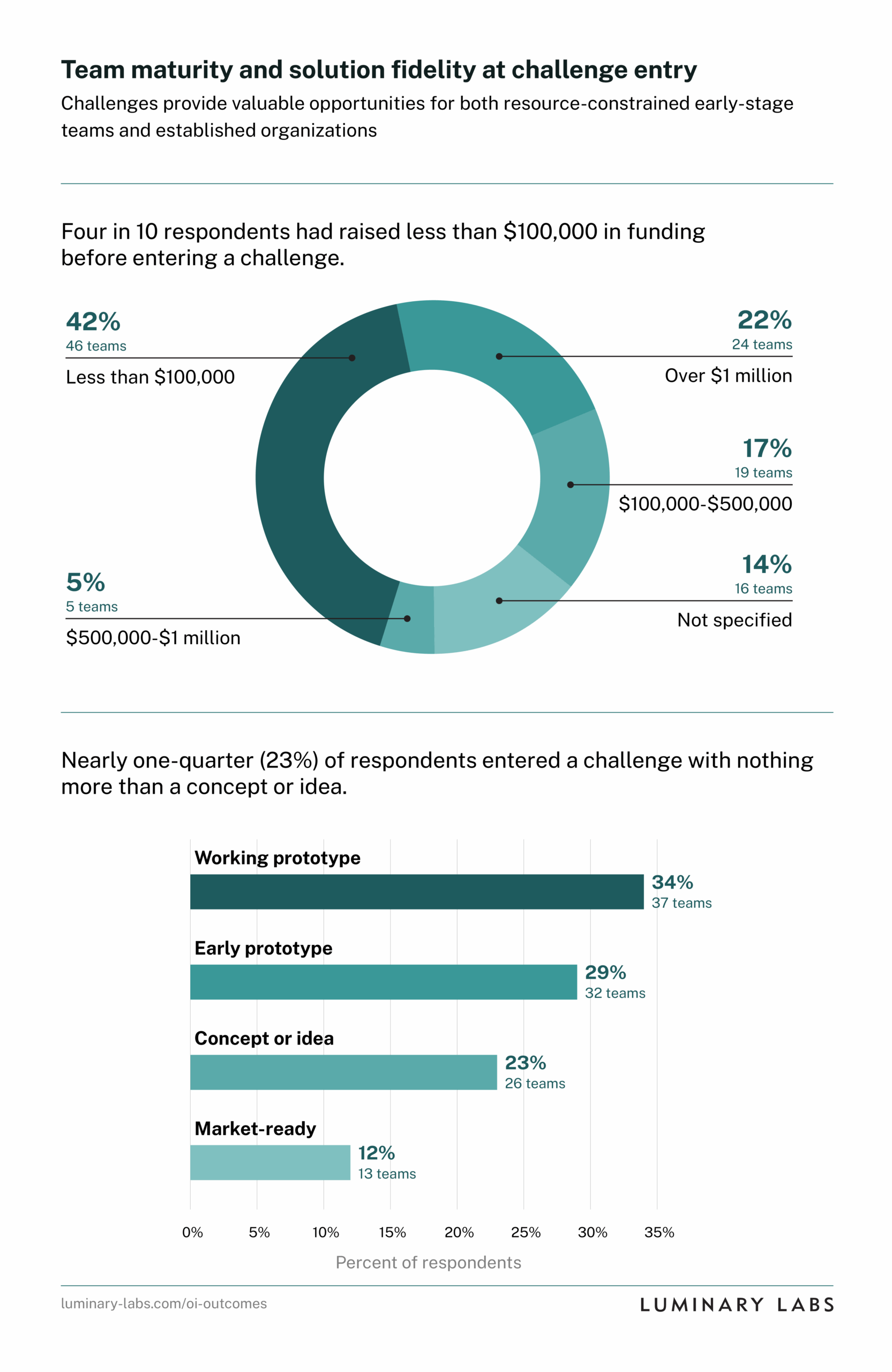Key insights from Luminary Labs’ 2025 open innovation outcomes survey.
When organizations invest in open innovation, they want to know what their return on that investment could be. Open innovation, which includes challenges and prize competitions, is a model or methodology that intentionally expands beyond internal resources, inviting external innovators and partners to help advance a goal or solve a problem. While venture capital relies on established success metrics and grant programs are frequently studied for their effectiveness, more practical surveys of open innovation outcomes are needed. (A few notable reports exist, including Kareem Lakhani’s study of Innocentive and NASA’s 2015 paper on outcome-driven open innovation). Evaluating innovation challenges can reveal the impact of sponsor investments and inform future program design, helping organizations understand how challenges set innovators up for long term success.
At Luminary Labs, we care deeply about outcomes. Over the past 14 years, we have designed and produced open innovation programs on behalf of public, private, and nonprofit organizations, representing more than $350 million in potential incentives for accelerating effective, scalable solutions. (These challenges and prize competitions are competitive, time-constrained initiatives that offer some form of incentive.) Naturally, we ask: What happened after the challenge? Our first open innovation outcomes survey in 2018 yielded valuable data and compelling evidence; this year, we once again asked winning teams: What happened after the challenge?
The results reveal that thoughtfully designed open innovation challenges don’t just identify solutions. When they include the right mix of incentives, support, and resources, challenges can catalyze lasting innovation ecosystems that generate value far beyond the initial competition. For many winners, the challenge is just the beginning. The winners we surveyed — 110 teams across 26 challenges — have continued to develop their solutions and raise significant post-challenge capital, achieving remarkable success beyond the competition itself. We have analyzed survey responses to identify themes and insights, showing how thoughtful program design can accelerate solutions from concept to market. Read on for more about what we learned from this survey.
In this article
- Post-challenge success: Funding, scaling, adoption, acquisition, and other indicators of ongoing growth.
- Market-shaping and ecosystem-building: How incentives and resources attract innovators to new problem spaces and accelerate viable solutions.
- Survey methodology: A closer look at who we surveyed and how we analyzed the data.
Post-challenge success
Open innovation challenges can set winners up for long term success.
The measure of a funding program’s success lies not merely in the amount of money awarded or the number of organizations involved, but in the subsequent outcomes.
For many respondents, challenge participation catalyzed post-challenge fundraising, supported commercial success, and helped solutions evolve into new products or services. The validation, networking, and strategic guidance provided to teams through open innovation challenges can create sustained value well beyond the initial competition period.
For many winners, the challenge is just the beginning.
We asked winning teams to report on what happened to their solutions after the challenge. Nine out of 10 respondents (89%) continued to develop their solutions after winning the challenge.
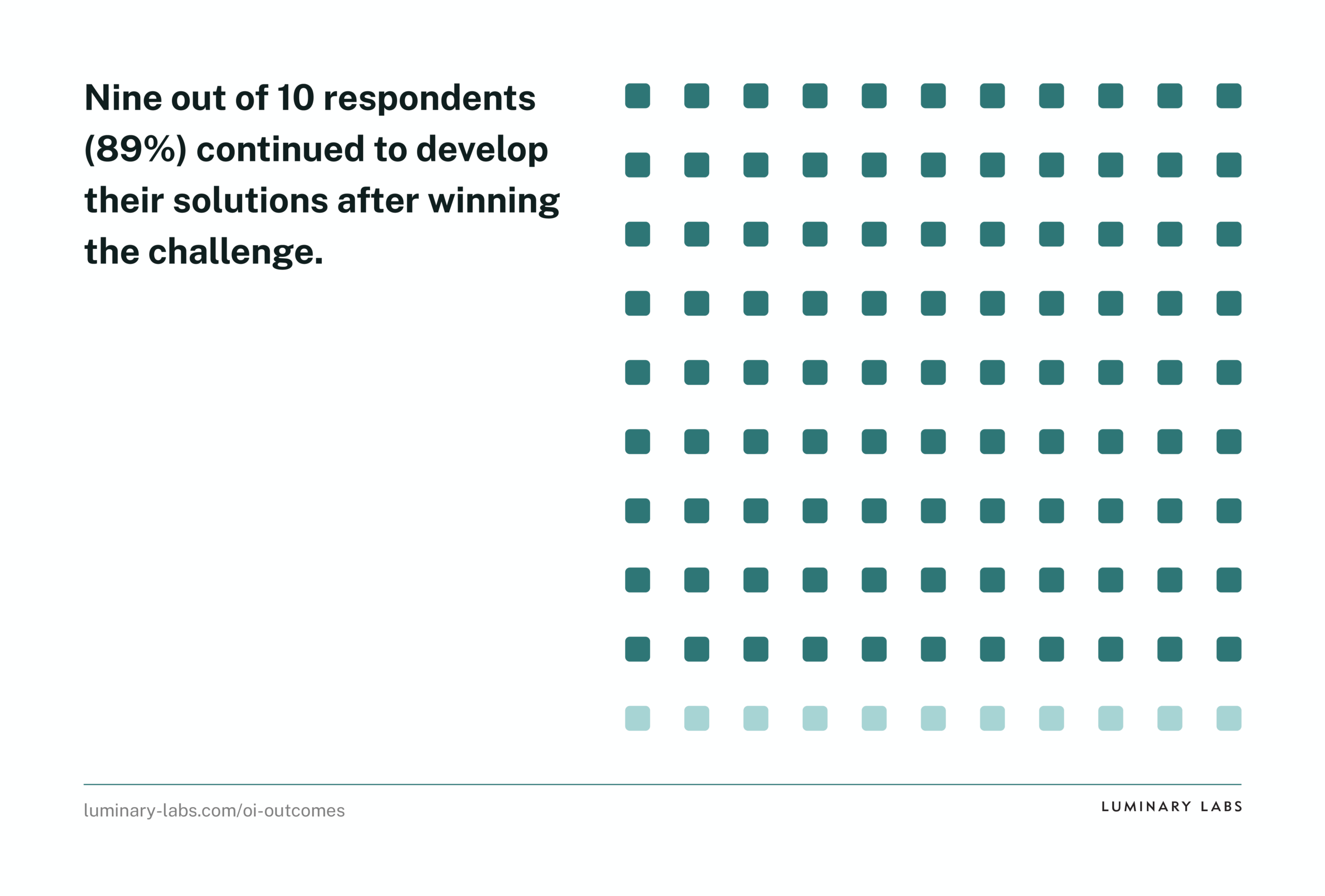
“Did you continue to develop your solution after the challenge?” Source: OI Outcomes survey merged dataset (n=110).
Of the 98 respondents that continued developing their solutions after the challenge, nearly two-thirds (62 teams or 63%) successfully secured funding to advance their work. Based on survey responses and additional desk research, we conservatively estimate that these 62 teams have collectively raised at least $630 million in post-challenge funding.
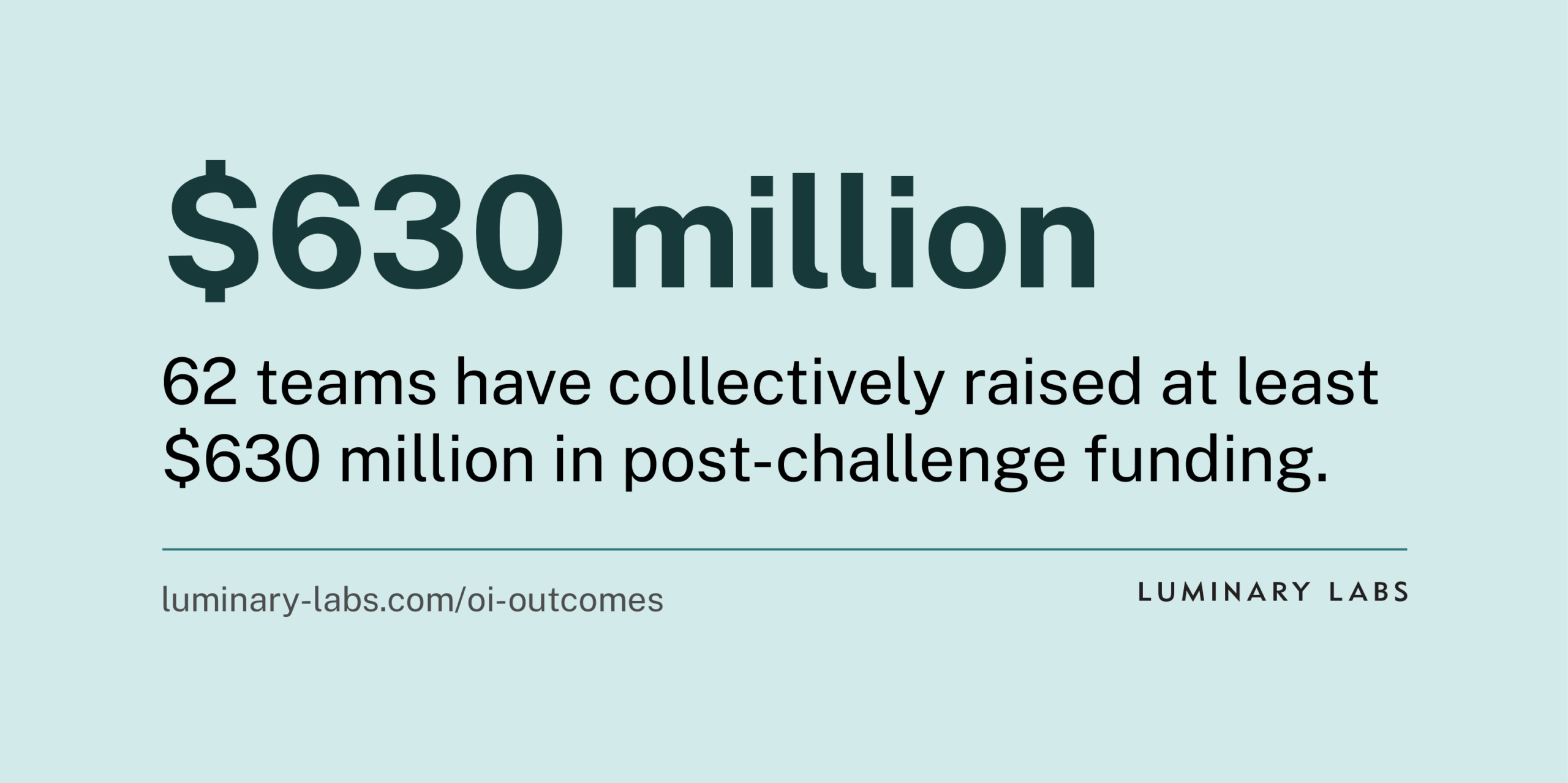
“Did you continue to develop your solution after the challenge?” and “How much additional funding have you received since the challenge?” Source: OI Outcomes survey merged dataset (n=110) and additional desk research.
Open innovation challenges can position innovators to access a wide spectrum of funding opportunities while reducing dependence on any single capital source. Respondents reported diverse sources of post-challenge funding, including both dilutive (for example, venture capital) and nondilutive (for example, prizes and grants) funding. Notably, more than one-third (37%) of respondents that reported post-challenge funding obtained it from multiple sources.
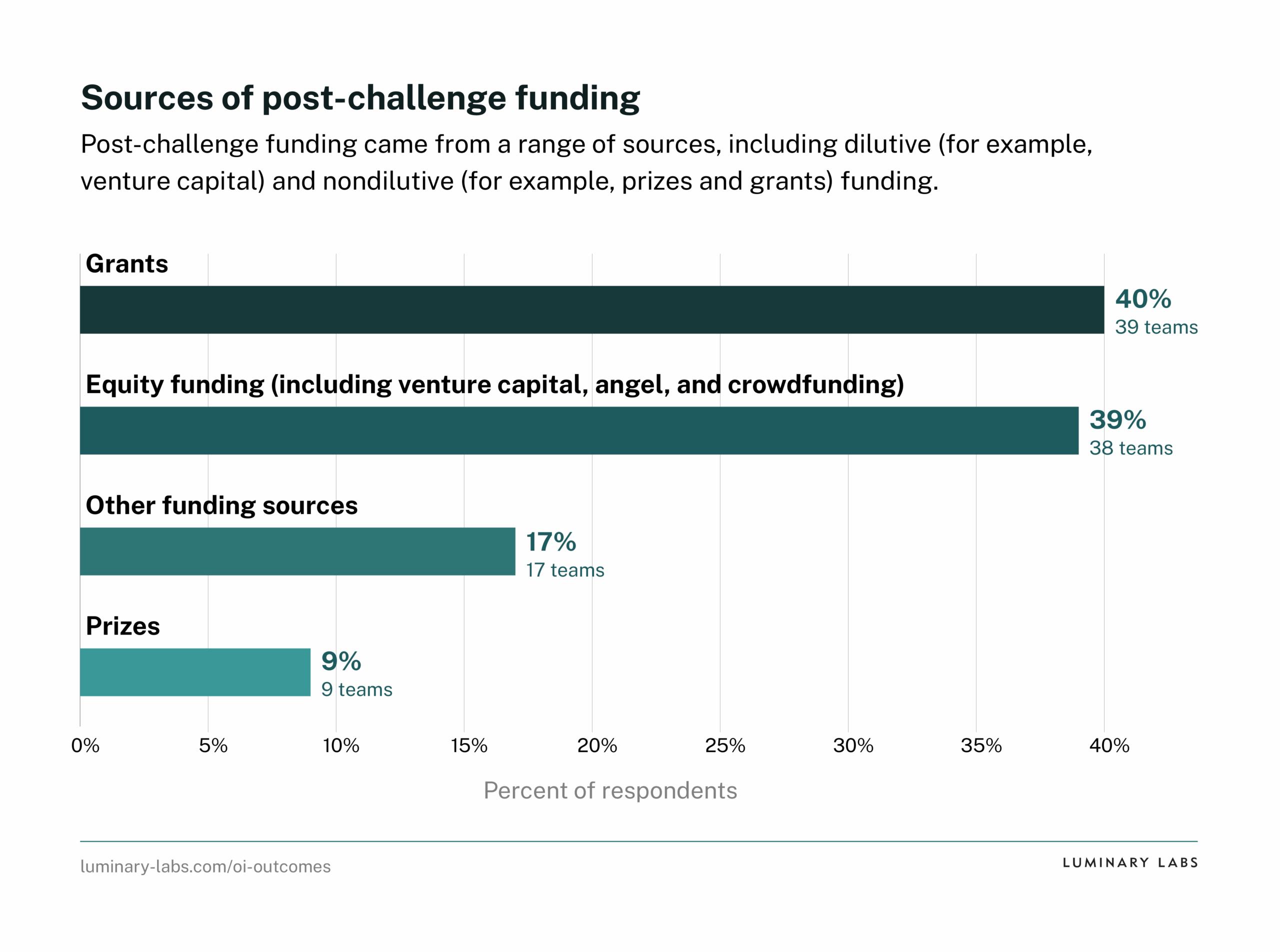
“What kind of funding have you received?” Respondents were asked to select all that apply; responses may not total 100%. Source: OI Outcomes survey merged dataset (n=98 respondents that continued to develop their solutions). 36% of respondents that did not receive additional funding are not represented in this chart.
Funding success stories
Consider the trajectory of Ginger.io, winner of the Data Design Diabetes Challenge (2011) and the Janssen Alzheimer’s Challenge (2012). Since winning, the company raised over $200 million in Series A-E funding, and in 2021, Ginger merged with Headspace to form a $3 billion digital mental health company.
Following the EdSim Challenge, Osso VR raised $2.4 million in capital and launched a partnership with eight American medical residency programs, including those at Columbia, UCLA, Harvard, and Vanderbilt. Since its challenge win, the company successfully closed multiple funding rounds, including a $66 million Series C financing round in 2022.
Wellframe, winner of the Merck | Heritage Provider Network Innovation Challenge, raised $45 million before it was acquired by HealthEdge. Prior to acquisition, Wellframe provided services to one-third of all U.S. health plans.
After winning the EdSim Challenge, the team behind Smart Sparrow formed a new company and won at least $7.5 million in post-challenge funding for multiple virtual reality based education products.
Post-challenge outcomes include other indicators of market viability.
While securing funding is an important metric of post-challenge success, it was not the only outcome winning teams reported. Winning teams went on to achieve commercial wins, evolve their solutions into new products or services, and file new patents related to their solutions.
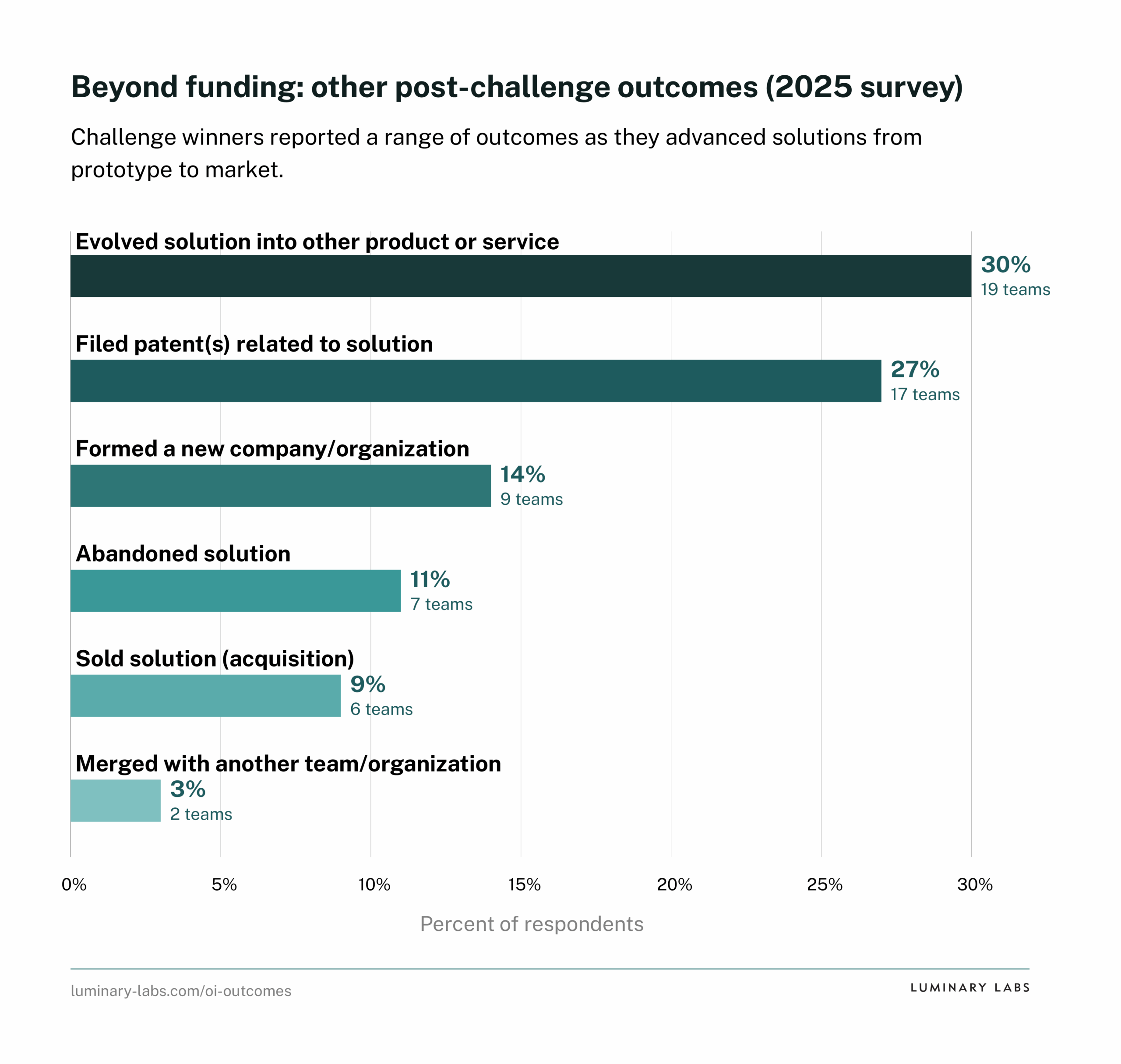
“What happened after the challenge?” Respondents were asked to select all that apply; responses may not total 100%. Source: OI Outcomes survey 2025 dataset (n=64 respondents that continued to develop their solutions).
Scaling, adoption, and acquisition
Ginger.io’s solution reimagined how smartphones could support emotional health, and through their challenge participation, the team formed partnerships with institutions like Cleveland Clinic and Stanford University. Today, Ginger is part of Headspace, and its product reaches millions of users globally.
After winning the EdSim Challenge, Embodied Labs scaled to serve over 1 million caregivers, generating multimillion-dollar recurring revenue. The company raised seed funding from five strategic venture capital funds and was globally recognized as the leading evidence-based immersive training platform for caregivers.
Since winning the Future Finder Challenge, Workbay has grown to support more than 250,000 adult learners across four states and has partnered with local workforce boards, chambers of commerce, and the Second Chance Business Coalition to engage thousands of employers, providing them with direct access to over a quarter million job seekers.
GUIDE App by Nlyten Corp, a finalist in the Mission Daybreak grand challenge, achieved nearly 100% adoption among firefighters and 50% adoption among police officers in Pennsylvania, completing clinical trials showing reduction in anxiety and depression.
In some cases, challenge winners formalized their teams and partnerships to create new entities. The Innovative Solutions Consortium and Johns Hopkins University evolved their concept from the Collaborate | Innovate Challenge into one of the largest clinical and omics data repositories in ALS research, forming a new 501(c)(3) organization, AnswerALS.org.
Acquisitions also signal solution success and wider market innovation. Major acquisitions reported in our survey include Ulula, purchased by EcoVadis in 2024 after six years of growth following the Rethink Supply Chains Challenge.
Following its Mission Daybreak win, NeuroFlow acquired Capital Solution Design and their Behavioral Health Lab (BHL) product, becoming the most widely used measurement-based care platform in the Veterans Health Administration.
FDA Food Safety Challenge winner Pronucleotein Biotechnologies’ rapid pathogen screening technology was acquired by CibusDx.
Other outcomes
Other respondents have contributed to their fields in meaningful ways. Teams published research, created open-source software, supported ongoing studies, and collaborated with federal agencies, demonstrating that evidence of success extends beyond traditional business outcomes. Several teams described finding new applications beyond their original intentions, with solutions serving as “technical bedrock” for subsequent projects.
Respondents that did not continue to develop their solutions after the challenge abandoned their work due to a range of circumstances. In write-in comments, respondents most frequently cited resource constraints as the reason for not continuing solution development.
Market-shaping and ecosystem-building
Open innovation challenges expand the ecosystem of solvers working on critical challenges.
Open innovation challenges can attract solvers across the innovation spectrum, from bootstrap startups to well-funded ventures, helping sponsors enlist new ideas and novel approaches from nontraditional players.
Designing a challenge requires balancing competing priorities to make intentional tradeoffs — weighing factors like solution maturity requirements, timeline constraints, evaluation criteria, and resource allocation. Understanding solver demographics and their needs can help challenge organizers design for impact.
Attracting new solvers to problem spaces
Most respondents entered challenges as early-stage ventures with limited funding, with more than four in 10 (42%) having raised less than $100,000 — including some teams that had no prior funding at all.
The majority of respondents (63%) entered a challenge with prototype-stage solutions rather than ideas or fully developed products, suggesting challenges attract teams at a critical development phase. These teams had more than just a concept or idea but had not yet reached full commercialization, representing a sweet spot where resources such as nondilutive funding, strategic guidance, and validation can have maximum impact. Only 12% of winning teams were “market-ready” at the start of a challenge.
Innovation challenges can also encourage people to combine their talents around compelling problems and incentives. This flexibility in team composition allows challenges to surface innovations that may not emerge through traditional organizational channels. One-third of respondents (33%) entered the challenge as a team of individuals or partnering organizations.
Great ideas are everywhere — what’s often missing is the catalyst to turn them into reality. For some innovators, that catalyst is funding. For others, access to mentorship, resources, or the right platform is the motivation that compels them to give their solution a chance.
Non-monetary resources incentivize teams and advance solutions.
Grants and other forms of push funding mechanisms can direct resources to advance specific goals, but prizes are uniquely suited to pull solutions forward with targeted incentives and resources. These survey results help us understand what motivates diverse solvers to participate in innovation challenges — and what they ultimately value most.
More than gold: Winning teams are motivated by non-monetary incentives.
Successful innovation competitions tap into multiple motivational drivers that inspire people to participate. The U.S. Prize Authority has identified four key motivations that drive solvers — sometimes referred to as the “four Gs:” the desire to create meaningful impact (good), the appeal of financial rewards (gold), the satisfaction of proving one’s capabilities (guts), and the recognition that comes with public validation (glory).
Effective competition design starts with understanding the fundamental barriers that have prevented a problem from being solved, identifying the types of innovators who might be equipped to address it, and knowing what they will need to meaningfully advance their solutions. The best programs thoughtfully combine financial incentives with other forms of support, helping participants overcome the practical obstacles that stand between a promising idea and a viable solution.
Consistent with results from our 2018 survey, most respondents were motivated to enter the challenge by financial incentives — the prize money — but that was far from the only motivation. Our most recent survey found that after cash awards (72%), respondents were primarily motivated by exposure to challenge sponsors and mentors (65%) and genuine interest in the problem space (60%), as well as opportunities for validation through press and other exposure (51%).
Validation and credibility offer additional unexpected benefits.
When asked to reflect on the greatest benefits of challenge participation, a vast majority of challenge winners (74%) valued the validation and credibility that came from winning and receiving press coverage even more than the cash prizes (71%). Networking opportunities with sponsors and industry leaders also ranked as a top benefit (64%), suggesting that challenges serve as powerful credibility engines. While prize money remains important, external validation and connections often prove even more valuable for teams looking to advance their solutions and attract future opportunities.
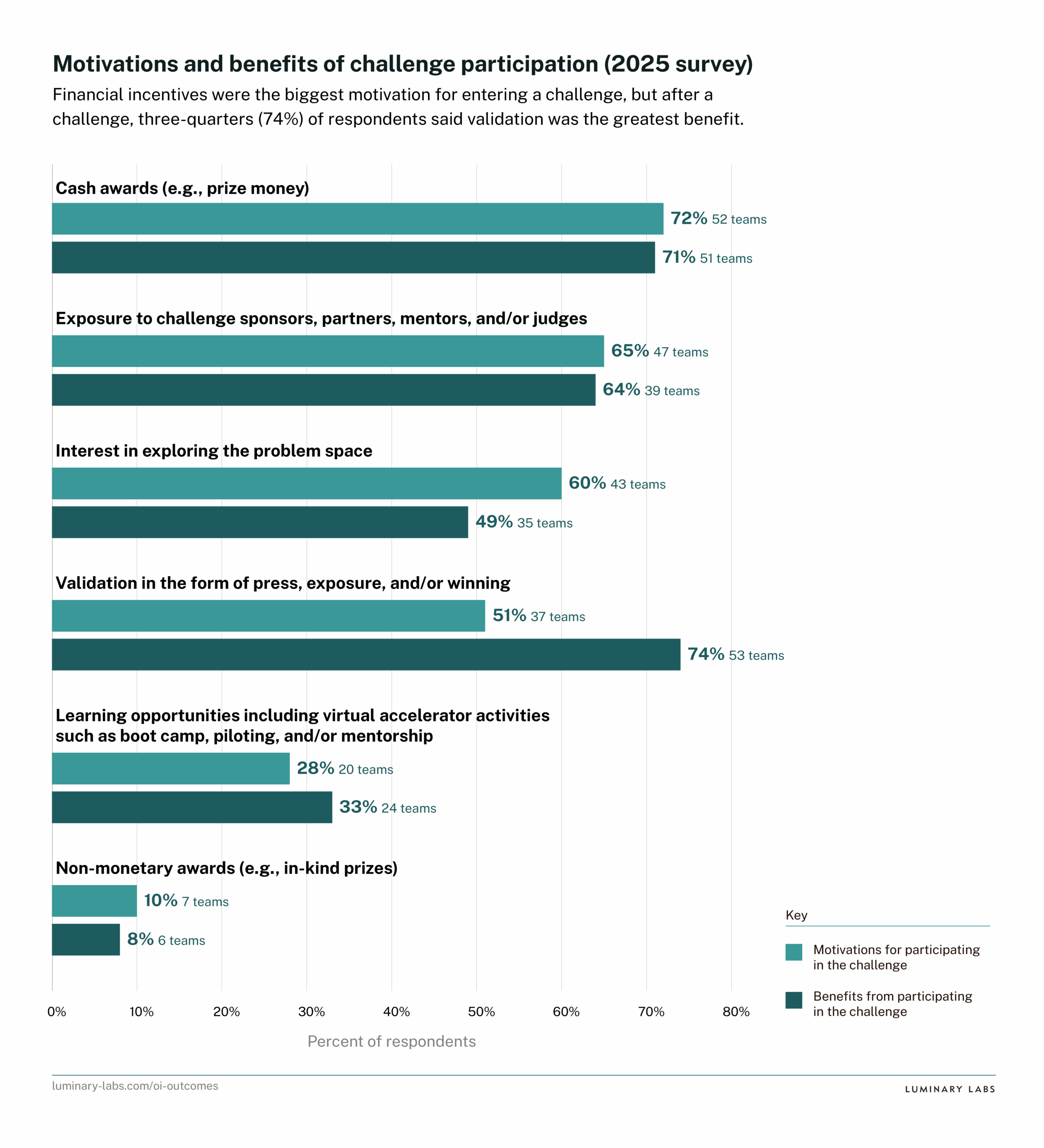
“What were your greatest motivations for entering the challenge?” Respondents selected their top three answers; responses may not total 100%. Source: OI Outcomes survey 2025 dataset (n=72). “What benefits did you receive from participating in the challenge?” Respondents selected multiple options; responses may not total 100%. Source: OI Outcomes survey 2025 dataset (n=72).
Participant perspectives
The qualitative responses reveal the depth of these ecosystem connections. As one respondent noted, “being part of the challenge connected us to the people doing meaningful work in the space. Our community has grown because of it.” Another shared, “I still work with some of the mentors from the challenge and in fact, some of our early investment came from [someone I met through the challenge].”
One winner explained the value of recognition: “Being able to say I had won something … validated my efforts,” while another described how winning “clearly lifted the international standing of our research and helped to attract additional funding.”
Learning experiences also generate lasting value. Respondents describe gaining invaluable skills, with one noting they “learned a tremendous amount from our FDA colleagues, Luminary Labs, and also how to package a complex idea into a form that results in clear communication of the science as well as the application.”
These ecosystem effects create network advantages that compound over time, connecting participants not only to sponsors and judges but to each other, forming professional relationships that extend far beyond the initial competition period.
Catalytic by design: how challenges accelerate emerging solutions
Well-designed open innovation challenges can be effective tools for accelerating breakthrough solutions from early concept to market impact. Challenges create inclusive pathways for different types of innovators to access not only capital, but the validation, networks, and strategic guidance that determine long-term success. With 89% of survey respondents continuing solution development and collectively raising at least $630 million in post-challenge funding, our outcomes survey shows how competitions can demonstrate remarkable efficiency in identifying and catalyzing high-potential innovations that might otherwise remain underdeveloped.
To be sure, competitions are not always the right mechanism. Understanding when to deploy the right funding strategy can help sponsors catalyze meaningful change. Competitions drive innovation forward when they clearly define the problem that needs to be solved, attract diverse solvers with thoughtful incentives beyond just money, and provide well-timed resources like mentorship and accelerators to help teams move from concept to viable solutions. By strategically balancing targeted incentives and the resources solvers actually need, effective competitions can address multiple barriers that otherwise prevent promising ideas from reaching their potential.
Survey methodology
This article is based on the Luminary Labs Open Innovation (OI) Outcomes surveys conducted in 2018 and 2025. For these surveys, we reached out to 177 winning entities — finalists, semifinalists, and grand-prize winners — from 26 open innovation challenges designed and produced by Luminary Labs from 2011 through 2024. The findings presented here are based on responses from 110 winning teams who answered the survey, representing nearly two-thirds (62%) of all teams that received awards from the challenges studied. Some findings reported here are based only on responses to the most recent (2025) survey, as noted in the text and charts.
To be sure, successful teams that have continued their work are easier to contact and may be more likely to respond to a survey about outcomes. Understanding that successful teams may be more likely to respond to a survey focused on outcomes, we also considered the teams that did not complete the survey when presenting statistics about the percentage of teams that continued working on their solutions (nine out of 10 respondents, or 89%). Even if the 67 winning teams that did not respond to the survey had answered “no” to a question asking if they continued to develop their solutions after the challenge, we would still be able to report that more than half (55%) of all 177 winning teams continued to develop their solutions.
Of the 26 challenges represented in this survey, 16 were health-focused, six were focused on infrastructure, and four were focused on education. Challenges designed specifically to solicit entries from schools or education institutions were not included in this research. With few exceptions, multiphase challenges that are still ongoing were also excluded from this survey. Learn more about Luminary Labs’ open innovation work at luminary-labs.com/work/open-innovation/.

